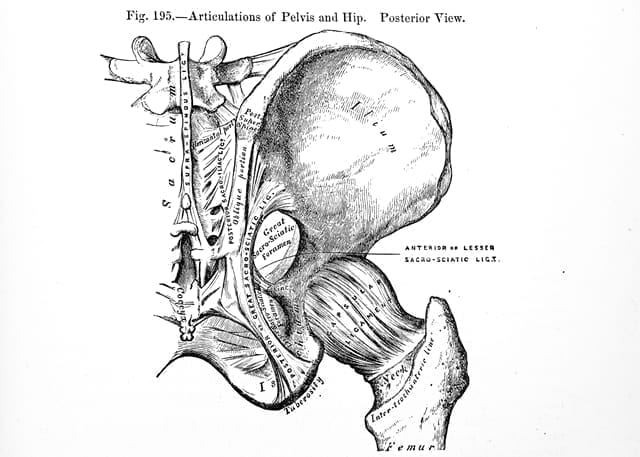Narveson, JR, Haberl, MD, Grabowski, PJ. Journal of Orthopedic & Sports Physical Therapy, 2016.
Abstracted by: Paige Koebbe, SPT at Missouri State University, Springfield, Missouri.
This study was done to investigate conservative treatment methods for patients with femoroacetabular impingement and acetabular labral tears, concluding intra-articular injections accompanied by conservative physical therapy can improve symptoms, strength, mobility, and functional activity tolerance.
This study utilized one female student-athlete with a diagnosis of an elevated center-edge angle and alpha angle, crossover sign, subtle cam impingement, and an acute anterior superior acetabular labral tear. The patient received an intra-articular hip injection, including a corticosteroid and a local anesthetic, thirty-two days following the injury date. The injection reduced the patient’s pain immediately, while still presenting with an abnormal gait pattern, reduced hip corrective strategies, range of motion and strength deficits, and pain when the hip was flexed, internally rotated, and adducted. A graded neuromotor training program was used for treatment intervention. This training program was broken down into four phases; muscular activation and hip corrective strategy, muscular endurance, static and dynamic postural control, return to running and skill-specific tasks, and return to sport and plyometric training (see Table 1 below). The labral tear was used to guide this intervention, but the patient’s symptoms origin was unclear. The intervention described was utilized to return to function and re-establish neuromotor control of the affected hip. This patient initiated a running program on day 3, beginning with running until symptoms begin. A difference in ER strength and hip correction strategies was noted post run as well as muscular flexibility. By focusing on patient symptom production, an individualized treatment intervention was developed to facilitate patient progression with activity-specific training without pain.
In conclusion, the findings revealed success with combined intervention for this patient with a femoroacetabular impingement and anterior superior acetabular labral tear. However, this was a case study utilizing only one participant, which reduces the strength of the results. These authors also noted a high level of self-motivation and rigorous compliance with home exercise program.
| Table 1 | |
| Visit Number | Interventions |
| Day 1 |
|
| Day 2 |
|
| Day 3 |
|
| Day 4 |
|
| Day 5 |
|
Personal Commentary:
This article was particularly interesting due to the controversy behind the “gold standard” for treatment of acetabular labral tears. “Gold standard” can be defined as an intervention, procedure, treatment, or method utilized and known as the best available. The authors collected data and information on a very misunderstood topic. Research on acetabular labral tears has been limited due to the different mechanisms of injury, wide array of symptoms and anatomical disruptions, and causes of hip pain. Many treatment interventions have been studied without success in finding a “gold standard.”
In the article described above, the authors indicated conservative treatment was effective in pain reduction and improvement in functional activities for this patient. However, the authors also recognized, this was a case study with one female patient, who was very compliant and motivated to improve. Other articles regarding conservative treatment have stated that patients with acetabular labral tears have not shown any signs of improvement. It is clear that, the “gold standard” for treatment of acetabular labral tears is still unknown to this day.
Currently, research supports the treatment intervention for acetabular labral tears is widely unknown. The study mentioned above is refuted through certain education and clinical experiences as well. Quality of life improvement through a variety treatment interventions is what physical therapists strive for daily. Regarding acetabular labral tears, conservative treatment is recommended first, in attempt to reduce costs and avoid surgical repair if possible. Thus, maintaining a level of diligence in monitoring patients’ progress from treatment session to treatment session is the key to success. It is suspected that labral tears can also increase a patient’s risk for developing hip osteoarthritis if not treated properly. Without irrefutable evidence of progress with conservative treatment, and attempting to reduce the risk of further injury, referral to an orthopedic physician to discuss surgical repair and facilitate quality of life improvement may benefit the patient long term.
References:
- Gold standard. (n.d.). Retrieved October 04, 2017, from http://medical-dictionary.thefreedictionary.com/gold standard
- Khoo-Summers, L., & Bloom, N. J. (2015). Examination and treatment of a professional ballet dancer with a suspected acetabular labral tear: A case report. Manual Therapy,20(4), 623-629.
- Mccarthy, J., Noble, P., Aluisio, F. V., Schuck, M., Wright, J., & Lee, J. (2003). Anatomy, pathologic features, and treatment of acetabular labral tears. Clinical Orthopaedics and Related Research,406, 38-47.
- Narveson, J. R., Haberl, M. D., & Grabowski, P. J. (2016). Management of a patient with acute acetabular labral tear and femoral acetabular impingement with intra-articular steroid injection and a neuromotor training program. Journal of Orthopaedic & Sports Physical Therapy,46(11), 965-975. doi:10.2519/jospt.2016.6573
- Orbell, S., & Smith, T. O. (2011). The physiotherapeutic treatment of acetabular labral tears. A systematic review. Advances in Physiotherapy,13(4), 153-161.

